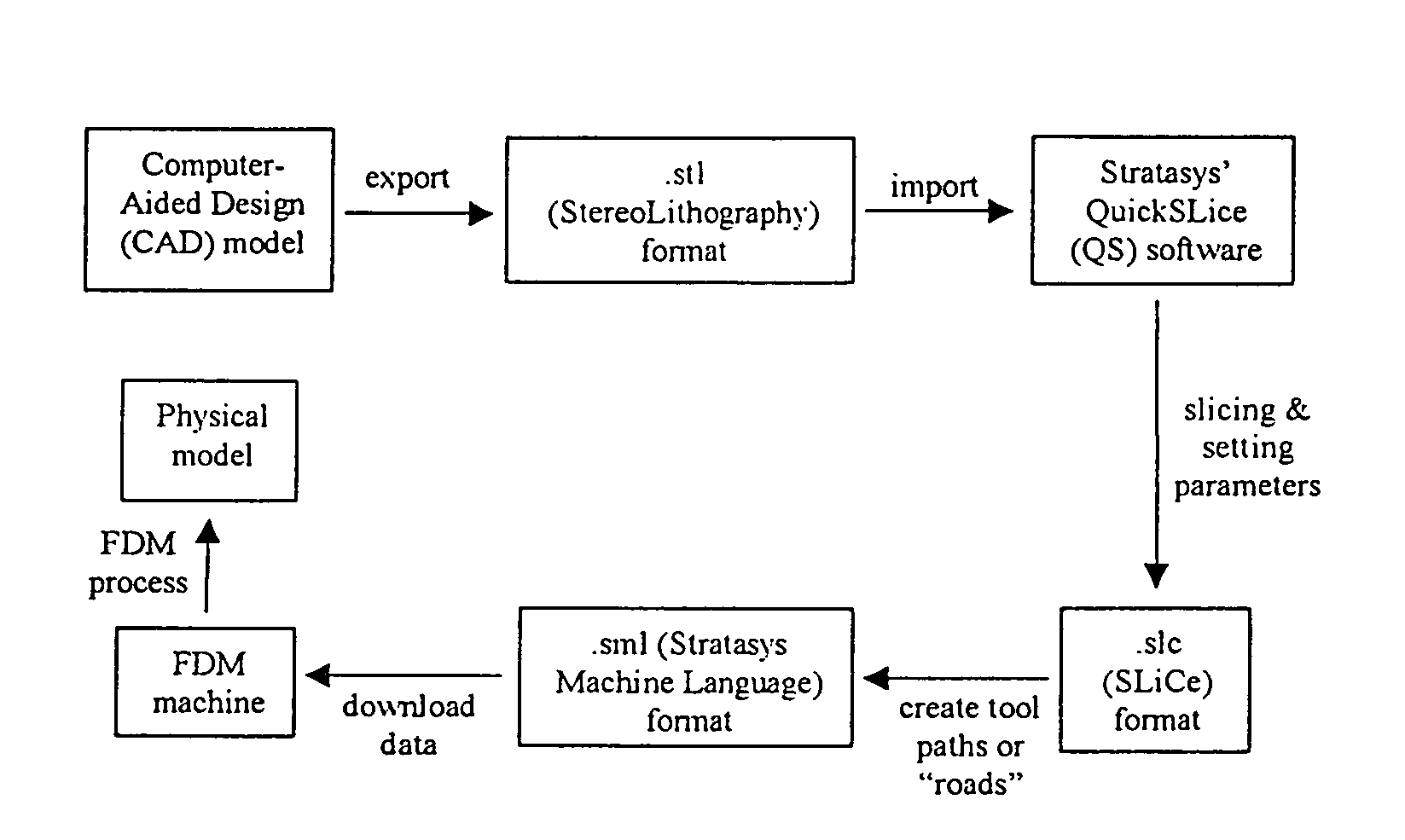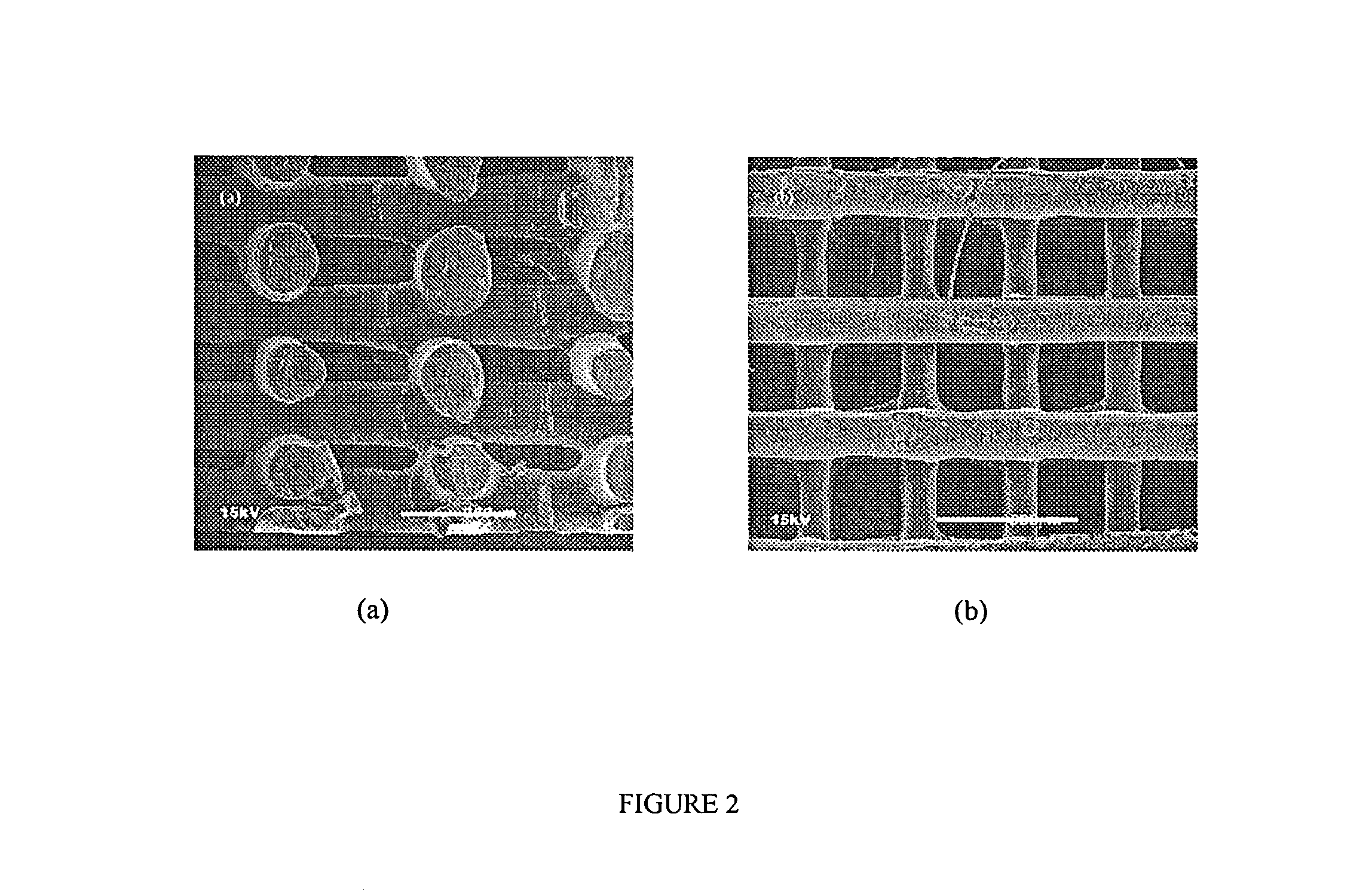Three-dimensional bioresorbable scaffolds for tissue engineering applications
a bioresorbable scaffold and tissue engineering technology, applied in the field of medical equipment and methods, can solve the problems of unsatisfactory two-dimensional scaffolds, increased bone grafting, and less satisfactory when generating functional tissues, so as to improve biocompatibility and hard tissue integration, avoid unfavorable environment, and increase initial flash spread of serum proteins
- Summary
- Abstract
- Description
- Claims
- Application Information
AI Technical Summary
Benefits of technology
Problems solved by technology
Method used
Image
Examples
example 1
(i) Scaffold Fabrication
[0094]Scaffold specimens were fabricated using PCL and PCL / HA filaments as described above with a FDM 3D Modeler rapid prototyping system from Stratasys Inc. (Eden Prairie, Minn.). Blocks of 32.0 (length)×25.5 (width)×13.5 mm (height) with a 61% porosity were created directly in the Stratasys' QuickSlice (QS) software. The head speed, fill gap, and raster angle for every layer were programmed through the QS software and saved as an .SLC, the (Slice) file format. Lay-down patterns of 0 / 60 / 120° and 0 / 72 / 144 / 36 / 108° were used to give a honeycomb-like pattern of triangular and polygonal pores, respectively.
[0095]The 2D slice data were converted into QS's .SML (Stratasys Machine Language) file format that automatically generated the build paths based on the input parameters for each slice layer. The .SML data was sent to the FDM machine to fabricate the scaffold specimens using a T16 tip. The liquefier temperature was set at 120° C. and the envelope temperature re...
example 2
(i) Cell Culture Experiments
[0102]One day prior to cell seeding, the 3D scaffolds were sterilized in 70% ethanol overnight. The ethanol was removed by centrifuging three times in changes of phosphate buffered saline (PBS) for 15 minutes with 1000 rpm.
(ii) Fibroblast Cultures And Seeding
[0103]Human fibroblasts were harvested from the Anterior Cruciate Ligament (ACL) of a 34 year old male patient. The fibroblasts were isolated via enzyme digestion by incubating at 37° C., 5% CO2 for 12 hrs with a collagenase-trypsin solution (Sigma, StLouis, Mo.). After the fourth passage, cultures were trypsinized and cell viability was examined via trypan blue (Sigma, St Louis, Mo.) exclusion. The cell pellets obtained after centrifuging the trypsinized cell suspensions were resuspended in 300 μl of DMEM and 450,000 cells in 30 μl were carefully seeded onto 16 scaffolds with a micropipette. The seeded scaffolds were left untouched for 2 hours to allow for protein secretion and cell attachment. A 2 m...
example 3
(i) Seeding and Culture of Chondrocytes
[0112]A study was performed to evaluate three scaffold / cell constructs with different physical and chemical properties, in their potential for tissue engineering elastic cartilage. Group I consisted of PCL scaffolds; Group II, custom-made non-woven PGA fibers; and Group III, collagen sponges. Chondrocytes were isolated from an ear cartilage biopsy of 2 year old male piglets and seeded in combination with a collagen based hydrogel and embedded in a fibrin glue capsule to protect the transplants from an immunological reaction from the host tissue. The specimens were then cultured for 1 week. The scaffold / cell constructs and controls were placed subcutaneously on the paravertebral fascia for 4½ month.
[0113]From the analysis of the histological, immunohistochemical, mechanical, and physico-chemical results of the tissue inside the different scaffolds, it was concluded that a PCL matrix supports cartilage formation whereas a textile construct made o...
PUM
| Property | Measurement | Unit |
|---|---|---|
| temperatures | aaaaa | aaaaa |
| decomposition temperature | aaaaa | aaaaa |
| Tm | aaaaa | aaaaa |
Abstract
Description
Claims
Application Information
 Login to View More
Login to View More - R&D
- Intellectual Property
- Life Sciences
- Materials
- Tech Scout
- Unparalleled Data Quality
- Higher Quality Content
- 60% Fewer Hallucinations
Browse by: Latest US Patents, China's latest patents, Technical Efficacy Thesaurus, Application Domain, Technology Topic, Popular Technical Reports.
© 2025 PatSnap. All rights reserved.Legal|Privacy policy|Modern Slavery Act Transparency Statement|Sitemap|About US| Contact US: help@patsnap.com



